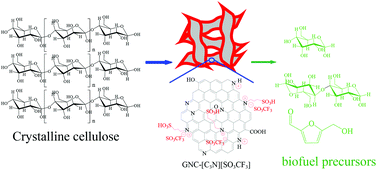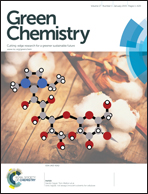Efficient biomass transformations catalyzed by graphene-like nanoporous carbons functionalized with strong acid ionic liquids and sulfonic groups†
Abstract
Strong acid ionic liquids and sulfonic group bifunctional graphene-like nanoporous carbons (GNC-SO3H-ILs) have been synthesized by treating nitrogen containing graphene-like nanoporous carbons (GNCs) with 1,3-propanesultone, ion exchanging with HSO3CF3 or H2SO4. Introducing nitrogen is important for grafting strong acid ionic liquids and sulfonic group in GNCs, which were synthesized from carbonization of a mixture of dicyandiamide or melamine and glucose. GNC-SO3H-ILs possess abundant nanopores, nanosheet structure, good dispersion and controlled acidity. By themselves, they are capable of enhancing the fast diffusion of reactants and products, while increasing the exposure degree of acidic sites in GNC-SO3H-ILs throughout various reactions. The above characteristics resulted in their much improved catalytic activity in biomass transformations such as the production of biodiesel and depolymerization of crystalline cellulose into sugars, which was even comparable to those of homogeneous ionic liquid and mineral acids.


 Please wait while we load your content...
Please wait while we load your content...